KNEC KCSE Past Papers 2017 Agriculture Paper 2 (443/2)
KCSE Past Papers 2017 Agriculture Paper 2
2017 Agriculture Paper 2
SECTION A (30 marks)
Answer all the questions in this section in the spaces provided.
1. Name one breed of livestock under each of the following categories:
(a) dairy cattle (1/2 mark)
(b) dual purpose cattle (1/2 mark)
(c) dual purpose sheep (‘/2 mark)
(d) hair goat (1/2 mark)
2. State four egg abnormalities observed during egg candling. (2 marks)
3. Give four reasons for livestock breeding. (2 marks)
4. Give two reasons for hoof trimming. (1 mark )
5. State four signs of Anthrax disease. (2 marks) 6. Name four methods of dehoming. (2 marks)
7. Give four reasons for keeping dairy animals healthy. (2 marks)
8. State four features of a clean milkman. (2 marks)
9. Name four maintenance practices for a wire fence.
10. State four reasons why dorper breed of sheep is good for mutton production.
11. State four control measures for tsetse flies.
12. Explain how each of the following is measured in cattle:
(a) blood temperature
(b) respiratory rate
(c) pulse rate
13. State the gestation period or each of the follwing:
(a) cow (1/2 mark)
(b) sow (1/2 mark)
(c) ewe (‘/2 mark)
(d) rabbit. (1/2 mark)
14. State four features of large white breed of pigs. (2 marks)
15. State four functions of worker bees in a bee colony. (2 marks)
16. state 3 ways of caponisation in poultry(1/2)
SECTION B (20 marks)
Answer all the questions in this section in the spaces provided. 17. The diagrams below represent farm tools and equipment.

(a) Identify the tools labelled E and F.
E
F
(b) State one use of each of the tools labelled F and G
F
G
(c) State one advantage the tool labelled F has over E
18. The diagram below illustrates an external parasite of livestock.

(a) Identify the parasite. (1 mark)
(b) Apart from eggs and adults, name two other developmental stages of the parasite illustrated above. (1 mark)
(c) Name two livestock diseases transmitted by the illustrated parasite. (1 mark)
(d) Explain two ways in which the environment is altered to control the parasite illustrated above. (2 marks)
19. The diagram below shows a cross-sectiona of a fish pond
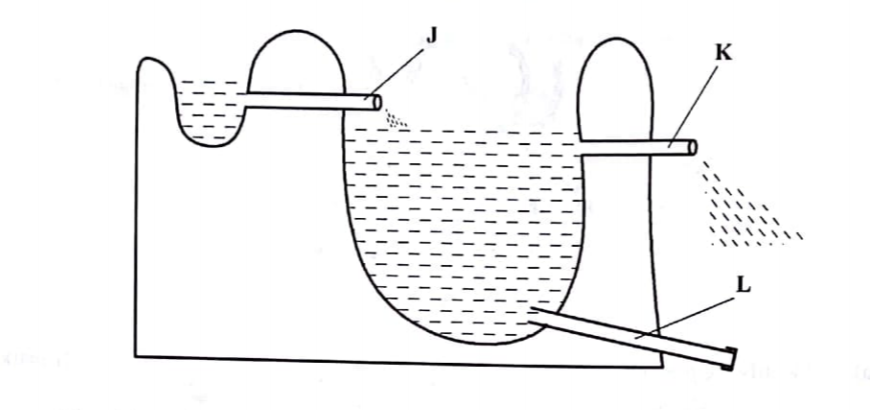
Name the part labelled
j
K
(b) State one function of the part labelled L
(c) Give one reason why the pond should have a deep end?
(e) Explain how fingerlings are introduced into a pond?
20. The diagram below shows calf presentations during parturation
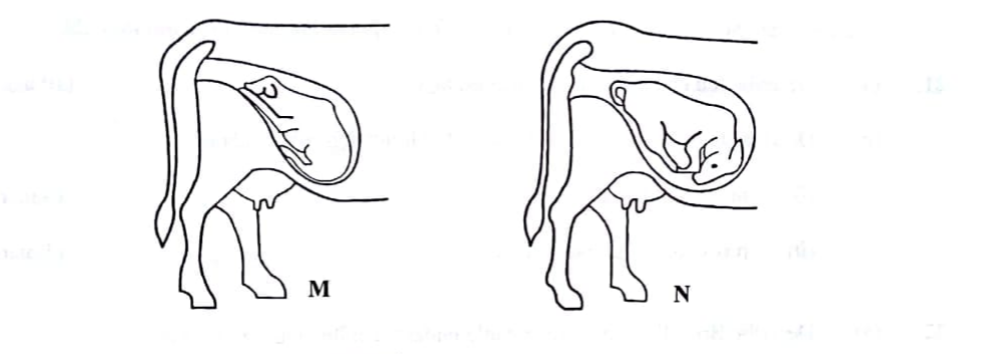
(a) Name the presentation labelled
M (1 mark)
N (1 mark)
(b) Which one of the two presentations requires the services of a qualified stockman? (1 mark)
(c) State two signs of parturition observed on the vulva. (2 marks)
SECTION C 140 marks
) Answer any two questions from this section in the spaces provided after question 23.
21. (a) Describe ten characteristics of a good layer.(10 marks)
(b) Describe the milking procedure under the following sub-headings:(5 marks)
(i) pre-milking practices
(ii) procedure of proper milking:(5 marks)
22. (a) Describe Brucellosis disease In cattle under the following sub-headings
(I) causal organism ( I mark )
(ii) signs of attack (4 marks)
(iii) control measures. 15 marks)
(b) Explain live factors that affect the digestibility of a feed material (5 mark )
(c) Explain five requirements of an artificial brooder in poultry rearing (5 mark )
23. (a) State five harmful effects of lice in pigs. (5 marks)
(b) Explain five structural requirements for a grain store. (15 marks)
(c) Describe five maintenance practices for the water cooling system of a tractor (15 marks)
(d) Give five differences between diesel and petrol engine, (15 marks)
Questions and Answers
2017 Agriculture Paper 2
Answer all the questions in this section in the spaces provided.
SECTION A (30 marks)
1. Name one breed of livestock under each of the following categories:
(a) dairy cattle
– Guernsey
– Friesian
– Ayrshires
– Jersey
(b) dual purpose cattle
– Sahiwal;
– Red poll;
– Sinunental
(c) dual purpose sheep
Romney mash;
– Carridale;
– Hampshire Down
(d) hair goat
– Angora;
2. State four egg abnormalities observed during egg candling. (2 marks)
– Blood spots;
– Hair cracks;
– Excessively porous shell;
– Fertilized eggs;
– Small size of air space;
– Meat sports;
3. Give four reasons for livestock breeding. (2 marks)
– Expand inherited potential of the animal;
– Increase productivity;
– Environmental adaptability;
– Satisfy consumers’ tastes;
– For increased growth rates for early maturity;
4. Give two reasons for hoof trimming. (1 mark )
– Prevent lameness;
– Control foot rot disease;
– Prevent injury during mating;
5. State four signs of Anthrax disease. (2 marks)
– underside of the body;
– Fever;
– Blood stained faeces and milk;
– Tar like watery blood discharge from orifices;
– Lack of rigor mortis in carcass;
– Blood does not clot quickly;
6. Name four methods of dewarming. (2 marks)
– Use of dehorning wire/saw;
– Use caustic potash stick (Potassium hydroxide);
– Use of disbudding iron;
– Use of rubber ring and elastrator;
– Use of dewarming collodion;
7. Give four reasons for keeping dairy animals healthy. (2 marks)
– Healthy animals grow fast and reach maturity early;
– Provide a long economic and productive life;
– To maximize production/performance;
– To produce good quality products;
– To prevent spread of diseases;
– Healthy animals are economical and easy to keep
8. State four features of a clean milkman. (2 marks)
– Free from contagious diseases;
– Physically clean;
– Wears white overall when milking and handling milk;
– Short finger nails;
– Covered hair;
9. Name four maintenance practices for a wire fence.
– Straighten loose or sagging wires using a wire strainer;
– Broken wires should be spliced;
– Worn out posts should be replaced;
– Broken brace posts and droppers should be replaced;
10. State four reasons why dorper breed of sheep is good for mutton production.
– Produce high quality carcass;
– Is highly prolific;
– Grows fast and matures early;
– Adapted to hot and dry areas;
11. State four control measures for tsetse flies.
– Bush clearing to destroy breeding grounds;
– Spraying breeding grounds with insecticides;
– Use of fly trap impregnated nets;
– Sterilization;
12. Explain how each of the following is measured in cattle:
(a) blood temperature
Using clinical/veterinary thermometer inserted in the rectum;
observing and counting the rate of inspiration/expira-tion per minute;
(b) respiratory rate
Using a respirometer;
(c) pulse rate
Place a finger or thumb on an artery passing on a bone or on the lower edge of the animal jaw
13. State the gestation period or each of the follwing:
(a) cow
– 270 — 285 days
(b) sow
– 113 — 117 days;
(c) ewe
– 150 days;
(d) rabbit
– 28 — 32 days;
14. State four features of large white breed of pigs. (2 marks)
– Long ana large;
– White with blue body spots;
– Broad and dished snout;
– Upright ears;
15. State four functions of worker bees in a bee colony. (2 marks)
– Feed the queen, drones and brood;
– Protect the hive from intruders;
– Collect nectar, pollen, tree nashis, gums, water etc; Build combs; – Seal cracks and creviceson the hive;
– Clean the hive;
– Make honey and bees wax;
16. state 3 ways of caponisation in poultry(1/2)
– Open method/surgical method;
– Implanting pellets of female sex hormone beneath the skin of the bird;
– Injecting with stilbestrol hormone when they are one day old;
SECTION B (20 marks)
Answer all the questions in this section in the spaces provided. 17. The diagrams below represent farm tools and equipment.

(a) Identify the tools labelled E and F.
E – open ended spanner;
F – Steel float;
(b) State one use of each of the tools labelled F and G
F– Loosening and tightening specific sized nuts and bolts;
G– Digging and collecting manure/trash;
(c) State one advantage the tool labelled F has over E
– provides a more firm grip on nuts and bolts;
– can work on nuts/bolts in depressions;
18. The diagram below illustrates an external parasite of livestock.

(a) Identify the parasite. (1 mark)
– Tick
(b) Apart from eggs and adults, name two other developmental stages of the parasite illustrated above. (1 mark)
– Larvae
– Nymph
(c) Name two livestock diseases transmitted by the illustrated parasite. (1 mark) – East Coast fever;
– Anaplasmosis;
– Heart water
(d) Explain two ways in which the environment is altered to control the parasite illustrated above. (2 marks)
– Ploughing pastures;
– Burning pastures;
– Top dress it using lime or acaricides;
19. The diagram below shows a cross-sectiona of a fish pond

Name the part labelled
j– Inlet
K– Spillway / overflow pipe;
(b) State one function of the part labelled L
– Drain the pond during harvesting/cropping
(c) Give one reason why the pond should have a deep end?
– Provide breeding ground for fish
(e) Explain how fingerlings are introduced into a pond?
– The container with fingerlings is gradually lowered into the pond and tilted for the fingerlings to swim away;
20. The diagram below shows calf presentations during parturation

(a) Name the presentation labelled
M (1 mark)– Normal presentation
N (1 mark)– Breech/mal-presentation
(b) Which one of the two presentations requires the services of a qualified stockman? (1 mark)– N – Breech presentation;
(c) State two signs of parturition observed on the vulva. (2 marks)– Enlarged and swollen;
– Clear mucus discharge;
SECTION C 140 marks
) Answer any two questions from this section in the spaces provided after question 23.
21. (a) Describe ten characteristics of a good layer.(10 marks)
– Combs and wattles are large, warm, waxy and red;
Bright orange and alert eyes;
– Pale beak;
– Oral, moist and reddish vent;
– Soft, pliable and wide abdomen;
– Space between the keel & pelvic bone is wide i.e. fits 3 -4 fingers;
– Alert and active in temperament;
– Dry and rugged plumages;
– Late moulting; – Pale shanks; – Broodiness is rare;
(b) Describe the milking procedure under the following sub-headings:(5 marks)
(i) pre-milking practices
– milking materials and equipment should be availed and within reach of milkman;
– Put the cow in the milking palour;
– Restrain the cow;
– Give food;
– Wash the udder and dry it with separation towels;
– Check for mastitis infection;
(ii) procedure of proper milking:(5 marks)
– Tightly grasp the teat at its base between the thumb and forefinger;
– to prevent back flow of milk into the gland cistern;
– Close in the other three fingers;
– applying pressure from top to bottom; to force the teat’s orifice open and drain milk out of the teat;
22. (a) Describe Brucellosis disease In cattle under the following sub-headings (I) causal organism ( I mark )
– Brucella abortus; bacteria;
(ii) signs of attack (4 marks)
Premature birth occurs;
– Retained placenta;
– Infertility;
– – Inflamed tests with low libido in bulls;
– Yellowish, brown slimy odourless discharge from the vulva at abortion;
(iii) control measures. 15 marks)
– Uses of A.I;
Culling/slaughter affected animals;
– Vaccination;
– Stockman should avoid contact with aborted foetus;
– Blood test on all breeding animals to detect infected Proper hygiene
(b) Explain live factors that affect the digestibility of a feed material (5 mark )
– Chemical composition of the food: Form in which the feed is offered to the animal;
– Species of the animal;
– Ratio of energy to protein;
– Quantity of food already present in the digestive system of the animal
(c) Explain five requirements of an artificial brooder in poultry rearing (5 mark )
– Litter on the floor; for insulation and absorption of moisture;
– Fresh air circulation;
– should have holes on the wall for ventilation/ gaseous exchange;
– Heat source;
– should be provided to maintain correct temperatures;
– Feeders and waterers;
– should be adequate to prevent overcrowding;
– Shape of the brooder should be round to prevent overcrowding that leads to suffocation;
23. (a) State five harmful effects of lice in pigs. (5 marks)
– Anaemia;
– Irritation;
– Emaciation;
– Poor feeding;
– Loss of hair;
– Wounds/scratches on the skin;
(b) Explain five structural requirements for a grain store. (15 marks)
– Vermin proof to keep away rats;
– Well ventilated to avoid dampness in the store;
-Water/leak proof to prevent dampness in the store;
– Easy to clean — free from cracks and crevices which harbor pests;
– Constructed above the ground to prevent dampness;
(c) Describe five maintenance practices for the water cooling system of a tractor (15 marks)
– Lubricate the water pump regularly;
– Use clean water in the radiator;
– Remove trash from the fins;
– Ensure all pipes are tightly fitted to avoid leakage;
– Fill the radiator with clean water before each day’s work;
– Check the fan belt tension regularly and adjust accordingly;
(d) Give five differences between diesel and petrol engine, (15 marks)
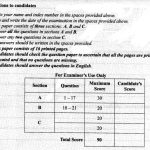


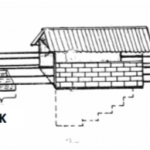
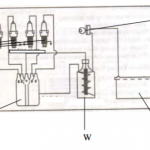
Add answers on final question
Answers for the last question